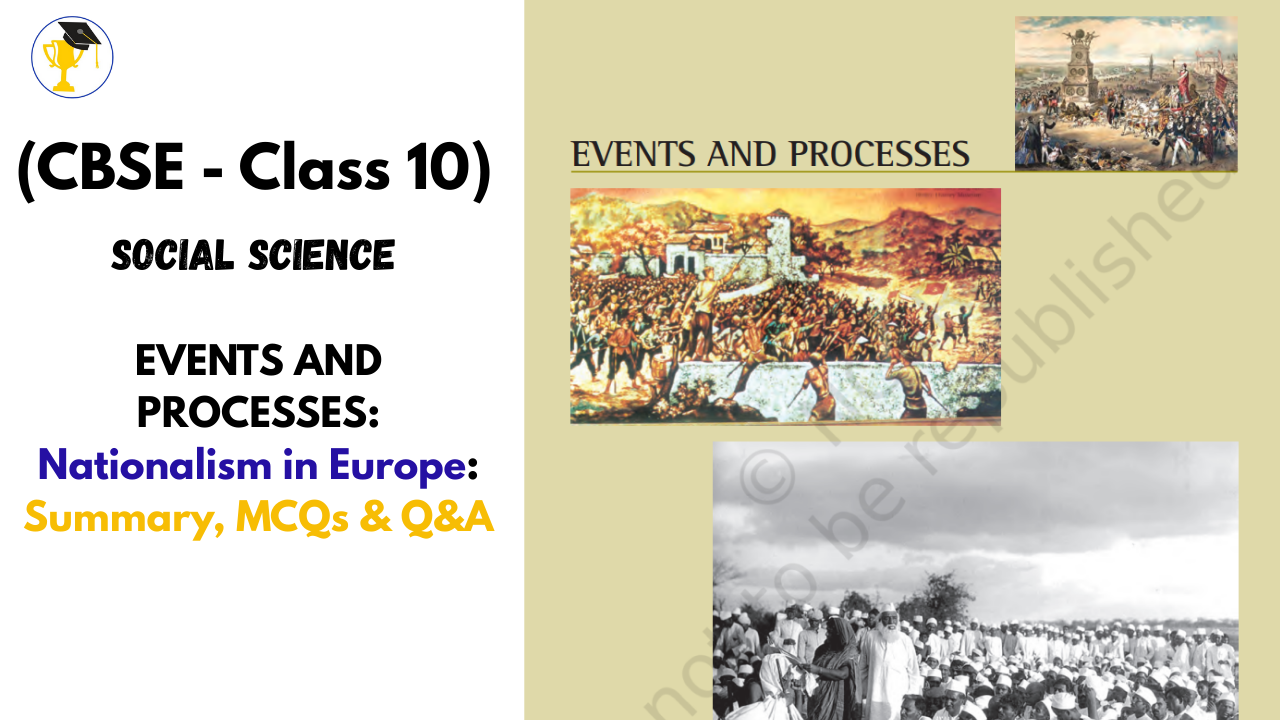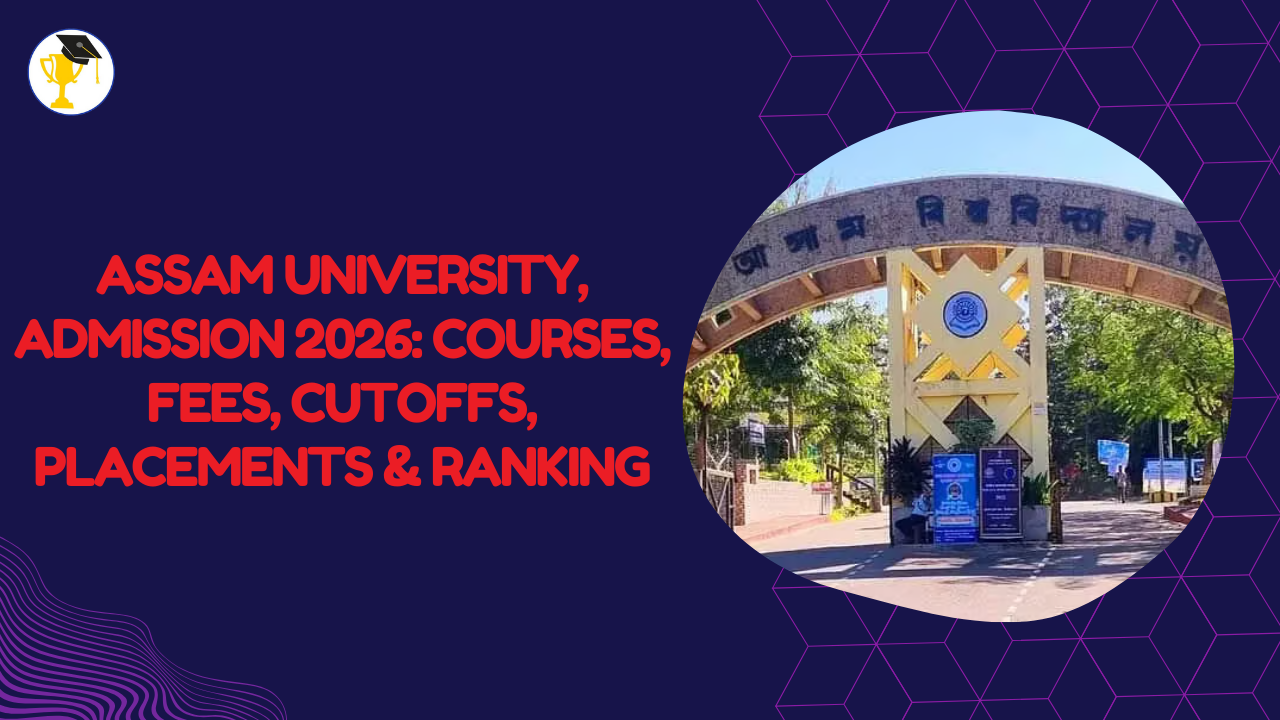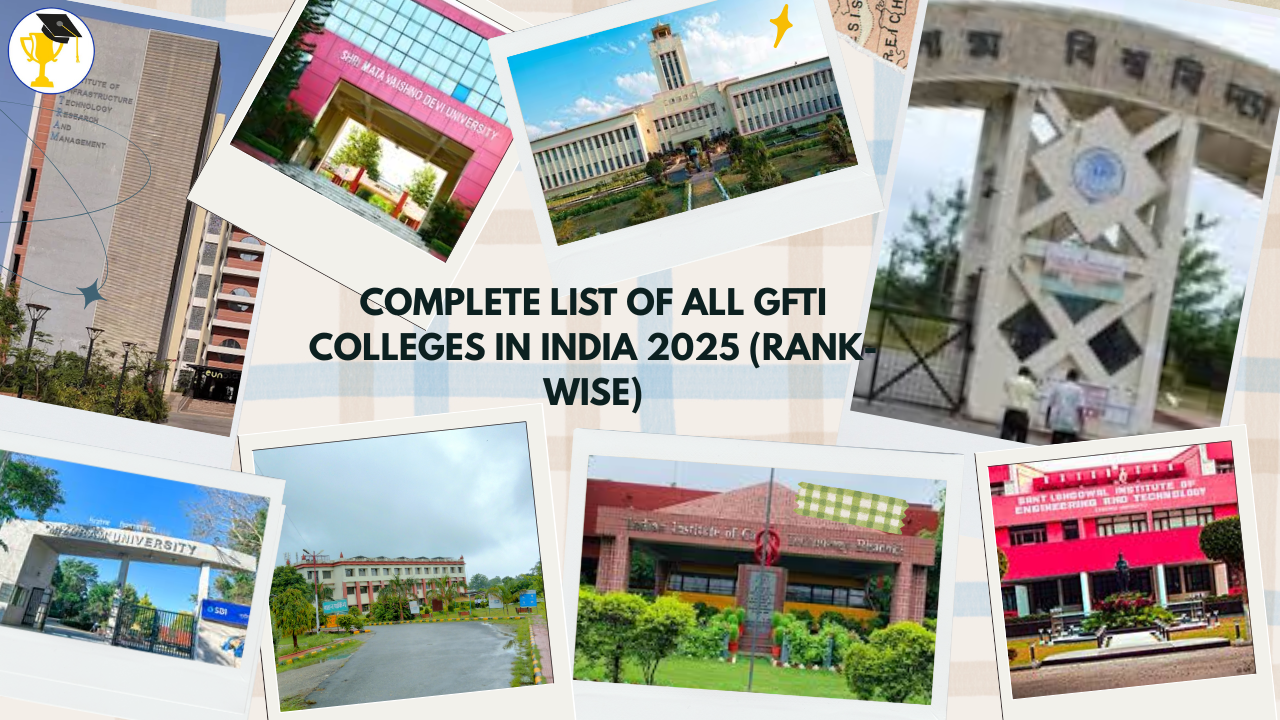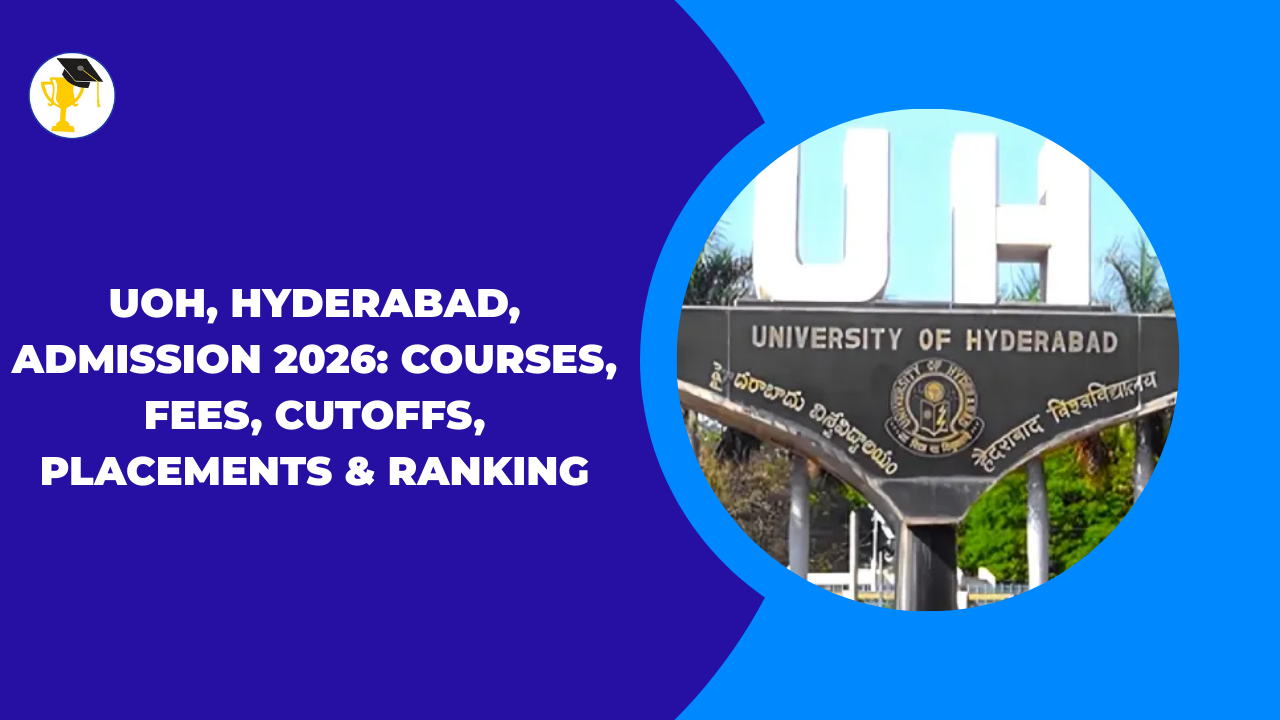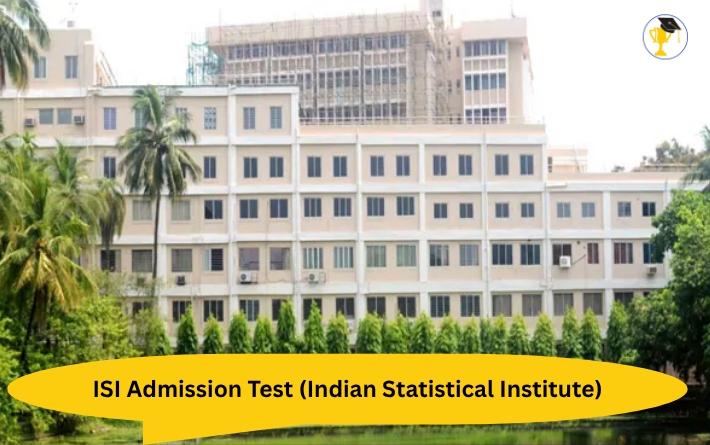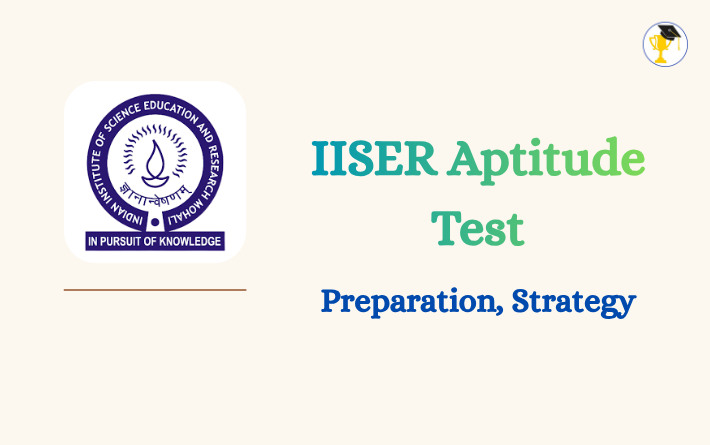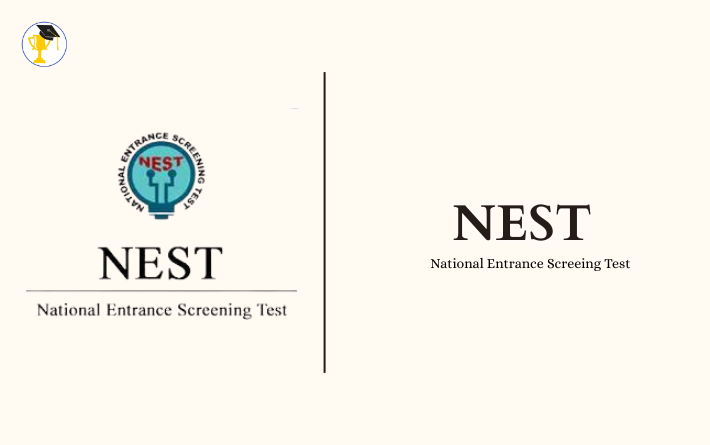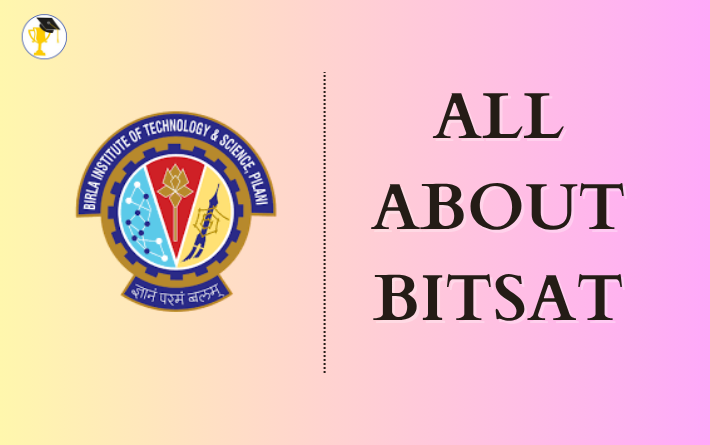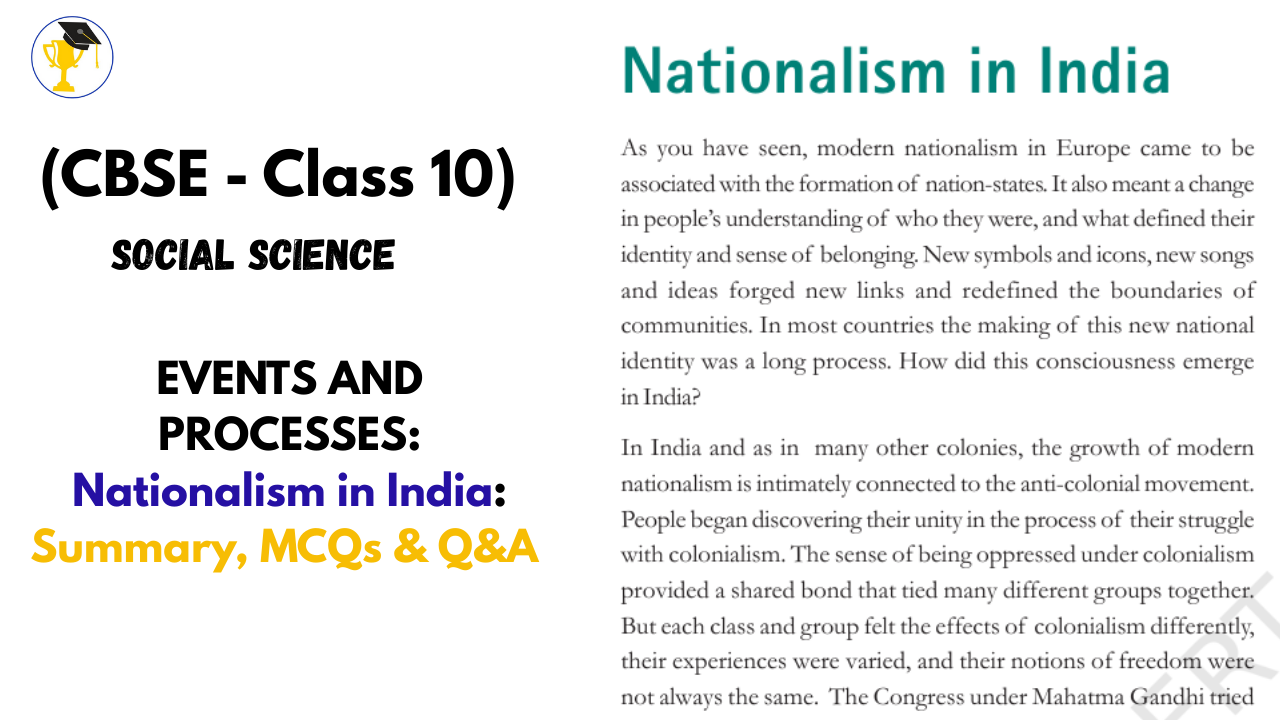
Class 10 Social Science – Nationalism in India (Chapter 2) Summary + MCQs + Q&A
CHAPTER SUMMARY: NATIONALISM IN INDIA
(Class 10 – History, Chapter 2)
Based entirely on your NCERT text
1. Background: Rise of Nationalism
-
Nationalism in India grew as part of the anti-colonial struggle.
-
Indians realized they were oppressed under colonial rule and developed unity through common suffering.
-
Different groups felt colonialism differently → unity wasn’t automatic.
2. First World War, Khilafat & Non-Cooperation
Effects of WWI
-
Huge rise in taxes, customs duties, and income tax.
-
Prices nearly doubled → hardship.
-
Forced recruitment of soldiers.
-
1918–21: Famine + influenza epidemic killed 12–13 million.
Gandhi Returns
-
Introduced Satyagraha → truth + non-violence as weapons.
-
Champaran (1917), Kheda (1917), Ahmedabad (1918) movements.
Rowlatt Act (1919)
-
Allowed arrest without trial → mass protests.
-
Led to Jallianwala Bagh massacre (13 April 1919).
-
British imposed martial law and used brutal repression.
Khilafat Movement
-
To support the Caliph (Ottoman ruler).
-
Led by Ali brothers (Muhammad Ali & Shaukat Ali).
-
Congress supported it to unite Hindus & Muslims.
Non-Cooperation Movement (1920)
-
Surrender of titles, boycott of schools, courts, foreign goods.
-
Spread widely, but violence at Chauri Chaura (1922) made Gandhi withdraw it.
3. Civil Disobedience Movement (Pg 38–45)
Why restart movement?
-
World Depression hit peasants.
-
Simon Commission of 1928 had no Indians → mass protests (“Go Back Simon”).
Purna Swaraj (1930)
-
Lahore Congress under Nehru declared Full Independence.
Salt March (1930)
-
Gandhi marched from Sabarmati to Dandi (240 miles).
-
Broke salt law → launched the Civil Disobedience Movement.
-
People now broke British laws, not just boycotted.
Who joined? Why?
-
Rich peasants: wanted lower revenue.
-
Poor peasants: wanted unpaid rent cancelled.
-
Tribal peasants: wanted forest rights (e.g., Alluri Sitaram Raju).
-
Businessmen: wanted freedom of trade (FICCI).
-
Women: marched, picketed, made salt.
-
Dalits: limited participation due to dispute between Gandhi & Ambedkar.
Gandhi-Irwin Pact (1931)
-
Gandhi agreed to attend Round Table Conference.
-
Political prisoners were released.
4. Sense of Collective Belonging
Nationalism grew through:
-
Images like Bharat Mata (by Abanindranath Tagore).
-
Folk tales & songs collected by nationalists (Tagore, Natesa Sastri).
-
Swadeshi symbols like the tricolour flag.
-
Reinterpretation of Indian history to instill pride.
MCQs
-
The Non-Cooperation Movement was withdrawn because of
a) Rowlatt Act
b) Jallianwala Bagh
c) Chauri Chaura incident
d) Simon Commission
Ans: c) -
Simon Commission was opposed because
a) It demanded more taxes
b) It included no Indian members
c) It cut military allowances
d) It banned Congress
Ans: b) -
Who led the tribal revolt in Gudem Hills?
a) Birsa Munda
b) Alluri Sitaram Raju
c) Baba Ramchandra
d) Titu Mir
Ans: b) -
Which symbol became central during the Swadeshi movement?
a) Lotus
b) Wheel
c) Tiger
d) Peacock
Ans: a) (8 lotuses on the early tricolour)
ASSERTION–REASON (A–R) QUESTIONS
Q1.
Assertion (A): Mahatma Gandhi chose salt as the symbol of protest in 1930.
Reason (R): Salt was consumed by only rich Indians.
a) A is true, R is true and R is the correct explanation
b) A is true, R is true but R is NOT the correct explanation
c) A is true, R is false
d) A is false, R is true
Answer: c)
Salt was used by ALL, especially the poor; that’s why Gandhi chose it.
Q2.
Assertion (A): The Simon Commission was boycotted by Indians.
Reason (R): It did not include a single Indian member.
Answer: a)
Both are true, and R correctly explains A.
Q3.
Assertion (A): Gandhi withdrew the Non-Cooperation Movement in 1922.
Reason (R): The Chauri Chaura incident turned violent.
Answer: a)
Q4.
Assertion (A): The business class supported the Civil Disobedience Movement.
Reason (R): They wanted protection against foreign imports.
Answer: a)
CASE-BASED QUESTIONS
CASE 1: Salt March
PASSAGE
In 1930, Mahatma Gandhi began the historic march from Sabarmati Ashram to the coastal village of Dandi in Gujarat. The march covered a distance of 240 miles. On reaching the seashore, Gandhi broke the salt law by making salt from seawater. This simple act was a direct challenge to the British monopoly over salt production and marked the beginning of the Civil Disobedience Movement.
Q1. Why was the Salt March an effective symbol of resistance?
Ans: Because salt was used universally, and the salt law revealed the most oppressive face of British rule by taxing a basic necessity.
Q2. What was the length of the march?
Ans: 240 miles.
Q3. What law did Gandhi break at Dandi?
Ans: The British monopoly on salt production.
CASE 2: Jallianwala Bagh
PASSAGE
On 13 April 1919, thousands of men, women and children gathered in Jallianwala Bagh. Many had come to celebrate the festival of Baisakhi, while others arrived to peacefully protest against the Rowlatt Act. General Dyer entered the enclosed garden, blocked all exit points, and ordered his troops to open fire on the unarmed crowd without warning. Hundreds were killed. This brutal incident shocked the entire nation and marked a turning point in India’s struggle for freedom.
Q1. Why were people gathered at Jallianwala Bagh?
Ans: For the Baisakhi fair and to protest against the repressive Rowlatt Act.
Q2. What was Dyer’s intention?
Ans: To “produce a moral effect” and terrorize Indians into submission.
Q3. How did this event affect the National Movement?
Ans: It intensified anger, led to nationwide protests, and convinced many Indians that British rule was immoral.
CASE 3: Rowlatt Act & Satyagraha
PASSAGE
“In 1919, the British passed the Rowlatt Act despite unanimous opposition from Indian members of the Imperial Legislative Council. The Act allowed the government to detain political prisoners without trial for two years. Gandhi launched a nationwide Satyagraha against this unjust law. Rallies were held, shops closed, and workers went on strike. Alarmed by these protests, the British tried to suppress the movement by arresting local leaders and imposing martial law in many areas.”
Q1. Why was the Rowlatt Act opposed by Indians?
Ans: The Act permitted arrest without trial, which violated basic civil rights and gave the British unlimited powers of repression.
Q2. How did Gandhi respond to the Rowlatt Act?
Ans: Gandhi launched a nationwide Satyagraha, organizing hartals, peaceful protests, and mass civil agitation to oppose the unjust law.
Q3. How did the British react to the protests?
Ans: The British arrested local leaders, imposed martial law, and used harsh measures to crush the popular upsurge.
CASE 4: The Simon Commission
PASSAGE
“In 1927, the British government appointed the Simon Commission to look into constitutional reforms for India. The Commission did not include a single Indian member, which angered political groups across the country. When the Commission arrived in India in 1928, it was greeted with the slogan ‘Go Back Simon’. Even the Congress and Muslim League united to oppose this insult to Indian self-respect.”
Q1. Why did Indians oppose the Simon Commission?
Ans: Because it had no Indian members, insulting India’s demand for representation in framing constitutional reforms.
Q2. What slogan greeted the Commission wherever it went?
Ans: The slogan “Go Back Simon!” was shouted at every protest.
Q3. Which major political groups united to oppose it?
Ans: The Congress and the Muslim League both opposed the Commission.
CASE 5: Participation of Women
PASSAGE
“Women played a remarkable role during the Civil Disobedience Movement. Thousands came out of their homes for the first time, picketing foreign cloth and liquor shops, taking part in marches, and even making salt. They considered their participation a sacred duty to the nation. Although women worked actively in the struggle, the Congress still hesitated to give them positions of authority within the organisation.”
Q1. How did women contribute to the Civil Disobedience Movement?
Ans: Women joined marches, picketed shops, boycotted foreign goods, and even made salt, showing great courage and patriotism.
Q2. Why was their participation considered significant?
Ans: Because women had been traditionally confined to the home, and their mass participation reflected social awakening, unity, and national commitment.
Q3. Did the Congress allow women leadership roles? Why or why not?
Ans: No. The Congress welcomed their participation but was reluctant to offer leadership positions, as traditional beliefs still viewed women’s roles as domestic.
CASE 6: Rich Peasants & Poor Peasants
PASSAGE
“Rich peasant communities like the Patidars and Jats actively supported the Civil Disobedience Movement. They were hit by declining agricultural prices and found it difficult to pay the revenue demanded by the British. Poor peasants, however, were more concerned with the burden of rent. They wanted the movement to reduce their rent dues, but the Congress did not fully support their demands, fearing it would alienate landlords.”
Q1. Why did rich peasants support the Civil Disobedience Movement?
Ans: They wanted revenue reduction because falling prices during the Depression made it difficult to pay the heavy British taxes.
Q2. What did poor peasants hope to gain from the movement?
Ans: They hoped for remission of unpaid rent, as they struggled to pay landlords due to low income.
Q3. Why did Congress avoid supporting the no-rent campaigns?
Ans: Congress feared that supporting such campaigns would offend landlords and split the national movement.
CASE 7: Alluri Sitaram Raju & Tribal Revolt
PASSAGE
“In the Gudem Hills of Andhra Pradesh, tribals were angry because the British had restricted their access to forests, limiting their ability to graze cattle, gather fuelwood, and farm freely. Alluri Sitaram Raju, who claimed to have special spiritual powers, led a militant guerrilla movement. He admired Gandhi but believed India could only achieve freedom through armed resistance.”
Q1. What grievances did the tribals of Gudem Hills have?
Ans: The British enforced forest restrictions, preventing tribals from grazing cattle, collecting forest produce, and practising shifting cultivation.
Q2. Who led the tribal revolt and how did he inspire them?
Ans: Alluri Sitaram Raju inspired the tribals by preaching courage, claiming spiritual powers, and supporting guerrilla warfare.
Q3. How did Raju view Gandhi and violence?
Ans: He admired Gandhi but believed that Swaraj required armed struggle, not just non-violence.
VERY SHORT ANSWERS
Q1. When did Gandhi return to India from South Africa?
Ans: January 1915.
Q2. Who led the Awadh peasant movement?
Ans: Baba Ramchandra.
Q3. What slogan greeted the Simon Commission?
Ans: “Go Back Simon!”
Q4. What is Satyagraha?
Ans: A non-violent method based on truth and persuasion.
Q5. Which act allowed detention without trial?
Ans: Rowlatt Act.
SHORT ANSWER QUESTIONS
Q1. Why did peasants join the Non-Cooperation Movement?
Ans:
-
High rents and illegal taxes.
-
Forced labour (begar).
-
No security of tenure.
(Page 35)
Q2. Why was the Simon Commission opposed?
Ans:
-
It had no Indian members.
-
Indians wanted to frame their constitution.
-
Seen as disrespectful to Indian political aspirations.
(Page 39)
Q3. Explain three features of the Civil Disobedience Movement.
Ans:
-
Breaking colonial laws (salt law, forest laws).
-
Boycott of foreign goods, refusal to pay taxes.
-
Women’s mass participation.
(Page 40–42)
Q4. How did rich peasants participate in the Civil Disobedience Movement?
Ans:
-
Organized communities.
-
Refused to pay revenue.
-
Supported Gandhi for revenue reduction.
(Page 41)
LONG ANSWER QUESTIONS
LONG ANSWER 1
Q.1 Describe the events leading to the launch of the Non-Cooperation Movement.
The Non-Cooperation Movement emerged from a series of events that deeply angered Indians and convinced Mahatma Gandhi that British rule could be opposed only through mass struggle. First, the First World War created severe hardships due to increased taxes, forced recruitment, and price rise, which doubled between 1913–1918, causing widespread suffering. Soon after, the British introduced the Rowlatt Act (1919), allowing arrest without trial, which Indians saw as a direct attack on civil rights. The situation worsened with the horrific Jallianwala Bagh massacre, where General Dyer ordered open firing on a peaceful crowd, killing hundreds and creating national outrage. At the same time, the Khilafat issue united Hindus and Muslims, as Muslims feared the harsh treatment of the Ottoman Khalifa after WWI. Gandhi saw a historic chance to unite Indians and proposed non-cooperation with the colonial government—meaning the boycott of British schools, courts, titles, and foreign goods. At the Congress Session at Nagpur in 1920, the movement was officially adopted, marking the beginning of a nationwide, peaceful struggle against unjust British rule.
Q.2 Explain the different social groups that participated in the Civil Disobedience Movement and how they understood ‘Swaraj’.
The Civil Disobedience Movement attracted various social groups, each interpreting ‘Swaraj’ according to their own needs and aspirations. The rich peasants, such as the Patidars and Jats, were hit hard by the Great Depression because agricultural prices fell sharply. They viewed Swaraj as a fight against high revenue demands and supported the movement enthusiastically, hoping for revenue reduction. On the other hand, the poor peasants, mainly small tenants, struggled to pay rent to landlords and therefore imagined Swaraj as a time when their unpaid rent would be remitted. In tribal regions like Gudem Hills, tribals led by Alluri Sitaram Raju envisioned Swaraj as the restoration of forest rights, which the government had taken away by restricting access to forests. Meanwhile, the business class, represented by industrialists like G.D. Birla, supported the movement because they wanted free trade, protection from imported goods, and an end to British economic control. The women also joined the movement in large numbers, breaking domestic boundaries and participating in marches, picketing, and salt-making; for them, Swaraj symbolized self-respect and national service. However, the Dalits had a different perspective: leaders like Dr. B.R. Ambedkar demanded separate electorates and political rights, fearing that under Swaraj, caste discrimination might continue. Thus, Swaraj meant different things to different groups, reflecting India's social diversity.
Q.3 How did nationalism develop through culture in India?
Nationalism in India did not grow only through political movements but also through cultural revival that created emotional unity among Indians. One of the biggest cultural symbols was Bharat Mata, first envisioned by Bankim Chandra Chattopadhyay and later painted by Abanindranath Tagore. These images portrayed the nation as a divine mother, encouraging devotion, love, and sacrifice for the country. Nationalists also revived folk tales, songs, and legends because they believed these represented the authentic spirit of the common people and strengthened pride in India’s past. Leaders like Rabindranath Tagore collected Bengali ballads, while Natesa Sastri compiled Tamil folktales, arguing that folklore was the true voice of the nation. The Swadeshi movement introduced national symbols such as the tricolour flag with eight lotuses, representing the eight provinces, which later evolved into Gandhi’s flag with the charkha symbolizing self-reliance. Another important method was the reinterpretation of Indian history: nationalists highlighted India’s glorious ancient achievements in science, architecture, and culture, rejecting colonial claims that Indians were backward. Although these cultural tools helped build unity, they sometimes unintentionally excluded non-Hindus when Hindu imagery dominated. Still, cultural nationalism played a key role in shaping India’s collective identity and strengthening the freedom struggle.
For full chaper click on:
https://smartachievers.online/class-10-ncert-social-science-nationalism-in-india
Recent Posts
Class 10 Social Science – Nationalism in India (Chapter 2) Summary + MCQs + Q&A
Smartachivers
Nov 27,2025
Sant Longowal Institute of Engineering and technology, Admission 2026: Courses, Fees, Cutoffs, Placements & Ranking
Smartachivers
Nov 27,2025
Birla Institute of Technology, Mesra Admission 2026 – Courses, Fees, Cutoffs, Placements & Ranking
Smartachivers
Nov 27,2025
Class 10 Social Science – Nationalism in Europe (Ch.1) Complete Summary, MCQs & Q&A
Smartachivers
Nov 27,2025
Assam University (Silchar) — for the 2025-26 cycle: courses, fees, admission mode, cutoff/entrance basis, placements and ranking.
Smartachivers
Nov 26,2025
Complete 2025 Ranking of GFTI Colleges in India
Smartachivers
Nov 25,2025
UoH, Hyderabad, Admission 2026: Courses, Fees, Cutoffs, Placements & Ranking
Smartachivers
Nov 24,2025
Unlock Your Potential: Staying Disciplined in the Age of Smartphones
Smartachivers
Nov 21,2025
What to Do After 10th? A Complete Guide by Smart Achievers
Smartachivers
Nov 25,2025
NEET UG 2026 Biology: Preparation Tips to Score a Perfect 360 Marks
Smartachivers
Nov 19,2025
JEE Main 2026 Guide: Decoding Good Marks, Percentile & Rank
Smartachivers
Nov 19,2025
2026 CBSE Board Exams: Class 10 & 12 Theory and Practical Marks Breakup Now Available Online
Smartachivers
Nov 19,2025
ISI Admission Test 2026 – Exam Date, Eligibility, Syllabus, Pattern, Courses, Cut-Off & Preparation Guide
Smartachivers
Nov 18,2025
IISER Aptitude Test (IAT) 2026 – Exam Date, Eligibility, Syllabus, Pattern, Registration, Cut-Off & Preparation Guide
Smartachivers
Nov 18,2025
AIIMS Aptitude Test 2026 – NEET-Based Admission, Exam Pattern, Eligibility, Selection Process & Preparation Guide
Smartachivers
Nov 18,2025
CUET (UG) 2026 – Exam Date, Syllabus, Eligibility, Registration, Pattern, Cut-Off & Preparation Guide
Smartachivers
Nov 18,2025
NEST 2026 – Exam Date, Eligibility, Syllabus, Pattern, Registration & Preparation Guide
Smartachivers
Nov 18,2025
VITEEE 2026 – Exam Date, Eligibility, Syllabus, Fees, Registration, Cut-Off & Preparation Guide
Smartachivers
Nov 18,2025
BITSAT 2026 – Exam Date, Syllabus, Eligibility, Application, Pattern & Cut-Off
Smartachivers
Nov 18,2025
NEET-UG 2026-2027 – Exam Date, Eligibility, Syllabus, Registration & Preparation
Smartachivers
Nov 18,2025


